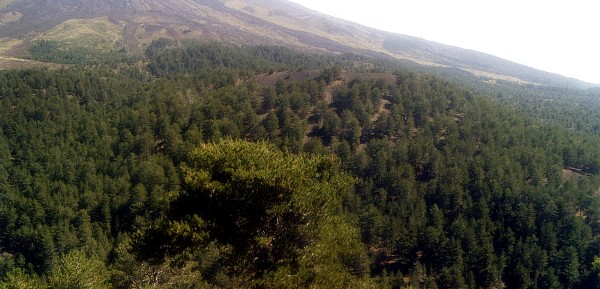| Etna
index |
||
| Geology | Geological history | Cones and craters |
| Eruptive characteristics | Eruptions before 1971 | Eruptions since 1971 |
| Etna and Man | References | Web sites |
| Weather forecasts | FAQ | Latest news |
 |
While
many of Etna's pyroclastic flank cones are very well visible,
some are so densely vegetated that they merge almost perfectly
with the surrounding forest. This is the case with Monte Capre,
which is morphologically well preserved and probably much younger
than nearby Monte Rosso (from which
this photograph was taken). Yet one has to look carefully to recognize
its crater rim, which bears somewhat less trees than its slopes
and consists of dark gray pyroclastics. Actually Monte Capre has
two summit craters and a third crater on its WSW side. The lower
part of Etna's main edifice is seen in the background; view is
to southeast. Photograph taken in September 2003 |
Mamma
Etna's countless children
Monte Capre
W flank, 14.94093° E, 37.74256° N
Summit elevation: 1883 m (W rim of W crater)
![]()
Lying
about 0.5 km from its conspicuous neighbor Monte
Rosso, Monte Capre shows a slightly more complex morphology, with
two east-west aligned craters in its summit area that lie about 0.22 km
apart. The highest point of this cone, about 100 above its western base,
lies on the western rim of the western crater. A third crater lies on
the lower WSW side of the cone. Monte Capre is about as vegetated as Monte
Rosso and presumably of similar age (a few thousand years old), although
the age relationship between the two has not been established.
Monte Capre is among those cones of Etna which I have not climbed so far
- I did pass on its western side in September 2003 but climbed only the
nearby Monte Rosso.
Copyright © Boris Behncke, "Italy's Volcanoes: The Cradle of Volcanology"
Page set up on 15 December 2003
